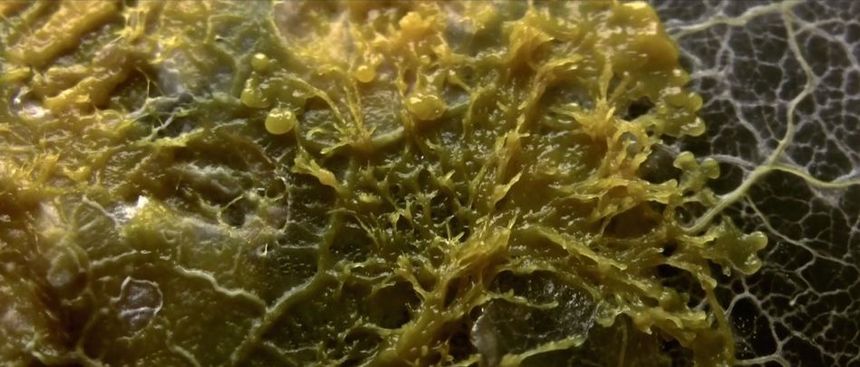Fantasia 2014 Review: THE CREEPING GARDEN Explores The Brave New World Of Plasmodial Slime Mould

In one of the year's most original and bizarre documentaries, Tim Grabham and Jasper Sharp dive headlong into the largely unknown world of plasmodial slime moulds, and what emerges is a pioneering and at times hypnotic crawl through a largely uncharted realm of mycological study.
Audiences will be forgiven for not knowing much, if anything at all, about mycetazoa - commonly known as slime moulds. As it turns out, almost nobody seems to have a clear concept of what these organisms are, or indeed whether they should be classified as plant, animal, funghi or something altogether different. With over 1000 different species currently documented, slime moulds appear to favour humid, damp environments - much like typical funghi - where they can feast on simple carbohydrate-rich plant life. Different species can appear quite unlike each other, from large luminous green globules to tiny yellow or red baubles, but what sets them apart from funghi, primarily, is that they move.
It is little wonder that past discoveries of slime moulds have made national headlines, with the fairly understandable suggestion raised that they might be extraterrestrial in origin. Bearing an uncanny likeness to the alien gelatinous mass from Irvin S. Yearworth's 50s paranoid classic, The Blob, those who have studied these organisms have documented problem-solving skills, the ability to communicate simple messages through its brain-and-nerveless body and even to hibernate for extended periods of time when food and environmental conditions become unfavourable.
Employing gorgeous time lapse photography, the film captures these bizarre, otherworldly entities as they ripple and undulate, navigate through mazes and feed on other matter to create a genuinely sci-fi-esque mood and spectacle. Collaborating with sometime Sonic Youth member Jim O'Rourke, The Creeping Garden also boasts a probing, unsettling aural landscape that only heightens our sense of cautious curiosity.
Mimicking the behavioural patterns of its subject matter, The Creeping Garden explores its narrative landscape almost by trial and error. Grabham and Sharp allow their impressive collection of passionate amateurs and eccentric professionals to lead the film down a series of digressive side roads, some of which shed revelatory light on slime moulds and their abilities, while others hit a creative cul-de-sac. The experts and filmmakers alike are quick to acknowledge that precious little is known about slime moulds and of what they are capable. It seems that responsibility for their academic study has fallen at the feet of mycologists - or funghi experts - but have largely been neglected. Where The Creeping Garden succeeds most is in gathering together the few disparate individuals who have devoted their studies to slime moulds, and attempting to reach some kind of cohesive common ground with their discoveries.
The results of these incredibly varied studies and applications prove as wide-reaching, innovative and baffling as the organisms themselves. We open with the simple woodland ramblings of an amateur mycologist - whose interest seems to begin and end with the discovery and observation of mycetazoa in their natural habitat - before moving on to robotics scientists, urban planners and even musicians, all determined to channel mycetazoan behaviour into something humanity can harness and make use of.
Along the way we drift into an impromptu history of the birth of cinema, and naturalist filmmaker Percy Smith's invention of time lapse photography - or time magnification as he termed it - to capture the behaviour of "magic mixies" on film. We follow the efforts of a project at Rotterdam's Biodesign museum to make human volunteers behave as if they were a single slime mould. We are treated to an artist's wallpaper designs using microscopic blow ups of cheek swabs and cervical smears "decorating our interior space with our interior space" as she puts it. At one moment, a mycology expert even stops to ponder exactly how a dog's penis might smell. It's a strange ride.
Tim Grabham has a history as an editor and cinematographer, and is previously responsible for the documentary KanZeOn, a fascinating exploration of traditional and experimental music in Japan. Jasper Sharp's name should be familiar as one of the foremost critics and historians of Japanese Cinema, particularly relating to the pinku and exploitation genres. The Creeping Garden is on its surface, perhaps the complete opposite of what one might expect from a collaboration of these two minds, but as we are drawn into this baffling, impenetrable yet somehow captivating topic, it is easy to see where their fascination comes from.
Imagine if Stanley Kubrick and Douglas Trumbull were tasked with making a 1970s educational science film about the pods from Don Siegel's Invasion of the Body Snatchers and you're some way to understanding The Creeping Garden. Ultimately, the film is as enigmatic, unique and fascinating as its subject matter, almost beyond categorisation, but filled with an insatiable child-like sense of wonder.
The Creeping Garden
Director(s)
- Tim Grabham
- Jasper Sharp

Do you feel this content is inappropriate or infringes upon your rights? Click here to report it, or see our DMCA policy.






